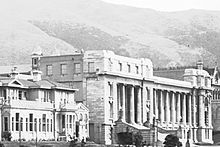New Zealand Legislative Council
| Legislative Council of New Zealand | |
|---|---|
| Type | |
| Type | |
| History | |
| Established | 1 July 1841 |
| Disbanded | 31 December 1951 |
| Leadership | |
| Elections | |
| Appointed by Governor-General | |
| Meeting place | |
 |
|
| Parliament House, Wellington | |
|
|
|
|
The Legislative Council of New Zealand was the first legislature of New Zealand from 1841 and upper house of the General Assembly of New Zealand from 1853 until 1950. Unlike the lower house, the New Zealand House of Representatives, the Legislative Council was appointed.
The Legislative Council was established by the Charter for Erecting the Colony of New Zealand on 16 November 1840, which created New Zealand as a Crown colony separate from New South Wales on 1 July 1841. Originally, the Legislative Council consisted of the Governor, Colonial Secretary and Colonial Treasurer. The Legislative Council had the power to issue Ordinances, statutory instruments.
With the passing of the New Zealand Constitution Act 1852, the Legislative Council became the upper house of the General Assembly in 1853.
The Legislative Council was intended to act as a revising chamber, scrutinising and amending bills which had been passed by the House of Representatives. It could not initiate bills, and was prohibited from amending money bills (legislation relating to finance and expenditure). The model for the Legislative Council's role was the House of Lords in the United Kingdom.
The New Zealand Constitution Act 1852 provided for councillors to be appointed for life terms by the Governor. As the power of the Governor over New Zealand politics gradually decreased, it became the convention that appointments were made on the recommendation of the Premier (later Prime Minister), essentially meaning that councillors were selected by the government of the day.
However, the life term of councillors meant that the Legislative Council always lagged behind the House of Representatives—Premiers were frequently hampered in their activities by a Legislative Council appointed by their predecessors. In 1891, life membership was replaced by a seven-year term by the new Liberal Party government of John Ballance. Part of the Liberal Party's motivation was probably ideological, but part was undoubtedly political, as Ballance's conservative predecessor, Harry Atkinson, had stacked the council with seven conservatives shortly before leaving office. Ballance had considerable difficulty in achieving his reform of the Council, with major clashes occurring between him and the Governor, The Earl of Onslow, who had approved the seven appointments. Ballance's victory is seen as establishing an important precedent in the relationship between Governor and Prime Minister. The seven appointments on 20 or 22 January to the Council were Atkinson himself (he was appointed Speaker) plus Charles Bowen, James Fulton, Charles John Johnston, John Davies Ormond, William Downie Stewart, Sr. and John Blair Whyte.
...
Wikipedia
